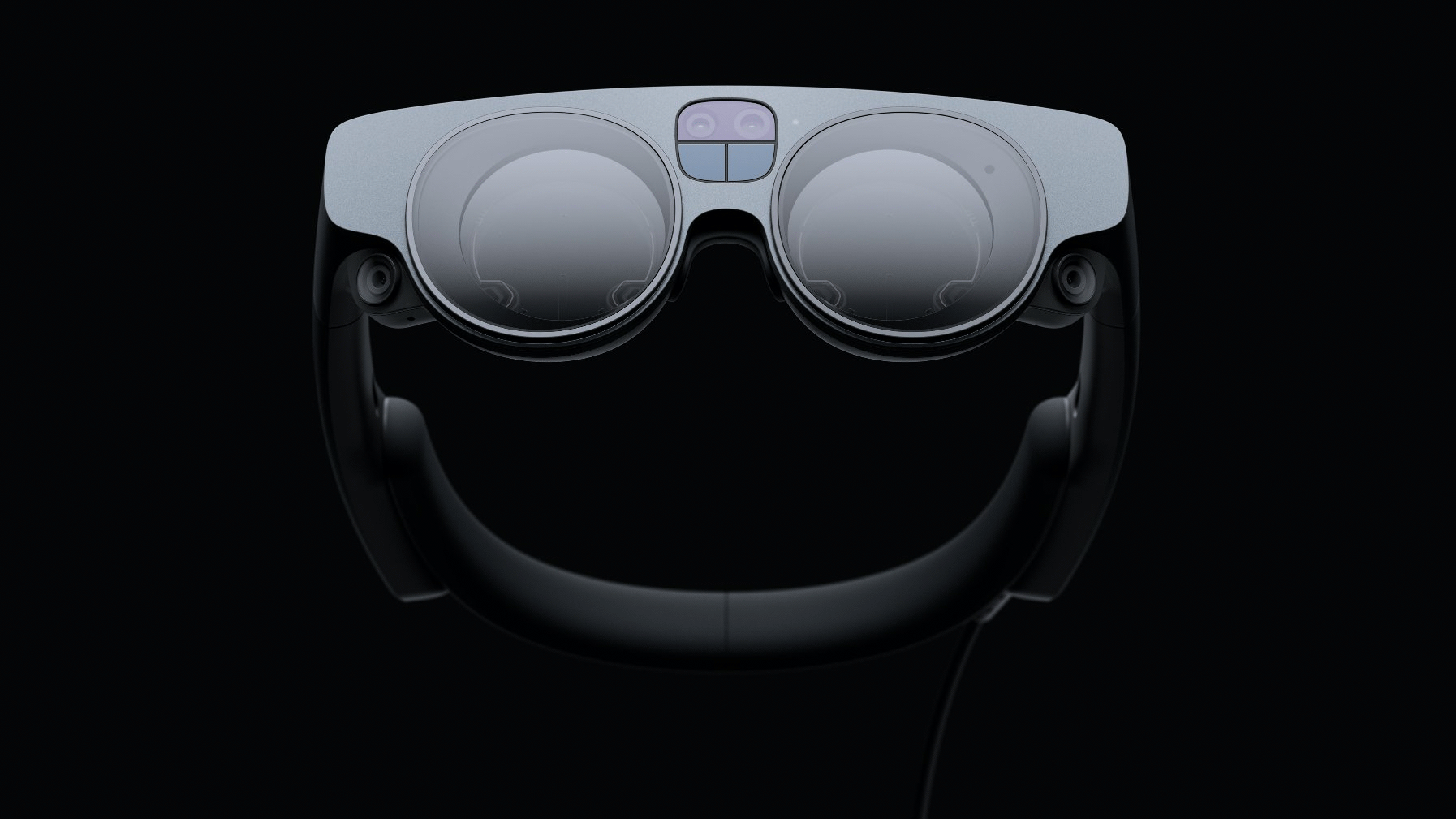Although it’s expected to launch this year, there’s still no firm release date on Magic Leap 2. However, the company has begun sharing details on the headset which suggests the launch is approaching.
This week at the SPIE Photonics West 2023 conference, Magic Leap’s VP of Optical Engineering, Kevin Curtis, took to the stage to share a bevy of new details on the headset. Attendee Nataliya Kosmyna shared portions of the presentation alongside some portions which cropped up over at the AR XR MR subreddit.
During the presentation Curtis detailed Magic Leap 2’s bevy of sensors, optical stack, Android foundation, and more.
The most interesting details to come from the presentation are perhaps about the headset’s dynamic dimming capability, which is a first among commercial AR headsets.
Dynamic Dimming Lenses
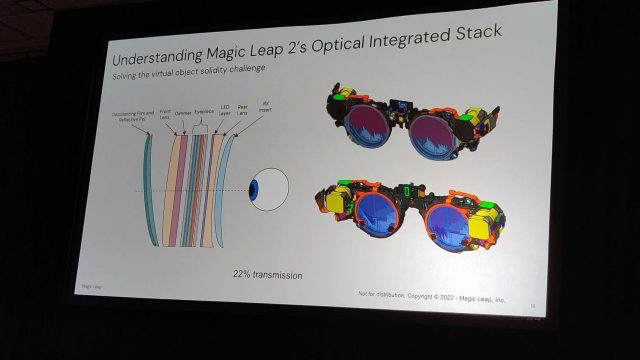
Curtis shared that Magic Leap 2 can adjust the light transmission of its lenses from 22% to 0.3%. The former being something like sunglasses and the latter being closer to welding goggles. This wide range ought to make the headset usable even in very bright outdoor environments (though it will of course come at the cost of dimming the world around the user as well). Dynamic dimming is paired with a brightness range from 20–2,000 nits; combined, these capabilities should make the headset significantly more flexible than its predecessor, and similar headsets, when it comes to varied lighting conditions.
Also noted in the presentation, the dimming capability can refresh at 120Hz, and is “segmented” as well. The slides state this means that Magic Leap 2 lenses can “enable black,” presumably by selectively dimming only the part of the lens where black is needed in the image. On traditional transparent AR headsets it’s impossible to have ‘black’ as a color because black is the absence of light but the lenses have no way to stop light from passing through. Without access to the entire contents of Curtis’ talk, we don’t know how precisely the dimming capability can be segmented so it’s difficult to know if this will be a comparatively groundbreaking capability, or something more limited.
Curiously, dropping to the minimum 0.3% light transmission might even make Magic Leap 2 useful for fully immersive VR experiences where the real world is largely dimmed to make way for entirely virtual content. It remains to be seen if this is a use case the company is actively aiming for.
The Headset
About the headset itself, Curtis shared that Magic Leap 2 will come in just one size—a change from Magic Leap 1 which had a ‘large’ and ‘small’ variant. The reasoning behind having two sizes for ML1 appears to have been driven largely by a small eyebox and the lack of IPD adjustment, requiring two different sizes of the headset to try to cover a suitable range of the IPD spectrum. For Magic Leap 2, Curtis says the eyebox was doubled in size, apparently making it large enough for the company to move to a single headset size.
According to Curtis, Magic Leap 2 weighs just 248 grams (0.5 pounds). That’s a nearly 22% reduction over the original headset’s 316 grams (0.7 pounds), while furthering its lead in weight over HoloLens 2 which comes in at a much heftier 566 grams (1.2 pounds). Granted, Magic Leap 2 still relies on a tethered connection to a ‘Compute Pack’ which gives it a big advantage in the weight department over fully self-contained headsets.
ML2 will also include eye-tracking, with two cameras per-eye. As far as we know, that’s up from one camera per-eye on ML1, which could mean greater accuracy. Eye illumination is provided by six tiny LEDs which can be seen embedded in each lens.
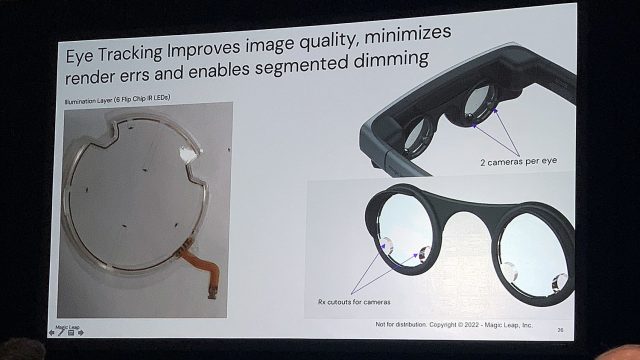
It isn’t clear yet if Magic Leap 2 will have the same varifocal capabilities as ML1. Given the diagram shared by Curtis (further above)—which appears to show one waveguide per red, green, and blue color (instead of two per color as with ML1)—the feature may have been scrapped.
The headset will include a 12MP RGB camera for user-facing photo capabilities, like taking pictures & videos, scanning barcodes, and streaming video for ‘see-what-I-see’ use-cases. On-board audio is also confirmed.
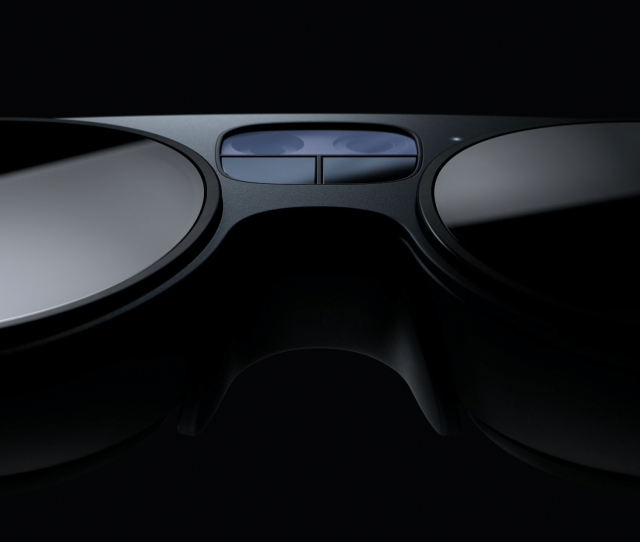
Two key things we don’t know yet are the resolution and field-of-view of Magic Leap 2. According to Curtis, Magic Leap 2 has “double” the field-of-view of ML1 (which is 50° diagonal), though we expect this means double the area, not double any of the linear dimensions. The company has previously shared this comparison of the ML2 field-of-view vs. ML1 in which we can see most of the gain comes in the vertical direction.

Compute Pack
As for performance, Curtis indicates the Magic Leap 2 ‘Compute Pack’ will have 2–3 times the GPU & CPU performance of Magic Leap 1, including the addition of a dedicated co-processor for handling computer-vision operations, which he referred to as the CVPU (computer-vision processing unit).
Curtis didn’t specify Magic Leap 2’s processor, but the company has strongly hinted that it comes from AMD. Interestingly, Magic Leap 1 was based on Nvidia’s Tegra chipset, which was fairly novel for this kind of device.
AMD is also a somewhat novel choice for Magic Leap 2 as most devices in this category use chips from Qualcomm, including Magic Leap’s main competition, HoloLens 2. You may know AMD as a creator of desktop & laptop processors as well as GPUs, but the company also has a significant foothold in the console market as the longstanding provider of chips in Xbox and PlayStation consoles. Magic Leap 2 could represent AMD’s first significant entry into the XR space.
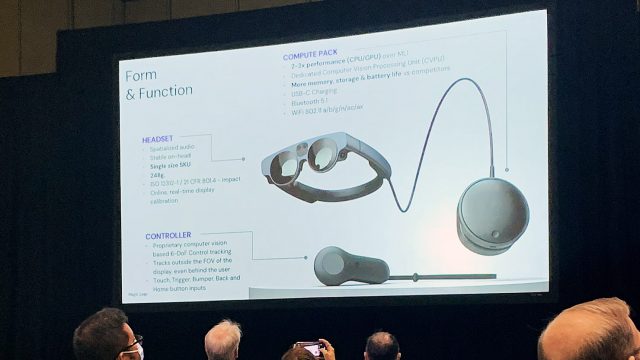
Magic Leap 2 also touts “more memory, storage, and battery life vs. competitors,” but we don’t have many specifics at this time. From the materials we have we know that ML2 will have USB-C charging, Bluetooth 5.1, and WiFi 802.11AX (AKA WiFi 6).
